BY: DR. Kaviraj Khialani – Celebrity Master Chef
INTRODUCTION OF DIWALI FESTIVAL
Diwali, also known as Deepavali, is one of the most widely celebrated festivals in India and by Indian communities around the world. It is a Hindu festival that usually falls in October or November, depending on the lunar calendar, and it typically lasts for five days.
Diwali is often referred to as the “Festival of Lights” because it symbolizes the victory of light over darkness and good over evil. The festival holds immense cultural and religious significance and is celebrated with great enthusiasm and joy.
The word “Diwali” is derived from the Sanskrit word “Deepavali,” which means a row of lights. The central theme of the festival is the lighting of oil lamps or diyas, candles, and decorative lights, which are placed in homes, temples, and public spaces. This tradition symbolizes the triumph of knowledge and righteousness over ignorance and darkness.
Diwali has several legends and myths associated with it, but one of the most popular stories is the return of Lord Rama to his kingdom of Ayodhya after defeating the demon king Ravana. The people of Ayodhya celebrated his return by lighting lamps and bursting fireworks, which is why Diwali is associated with the lighting of lamps and fireworks.
The festival also has a strong religious component, with worshippers performing special prayers and rituals. Many Hindus offer prayers to the goddess Lakshmi, the deity of wealth and prosperity, in the hope of inviting her blessings into their homes. Additionally, Diwali is an occasion for family gatherings, feasting, exchanging gifts, and sharing sweets and savories.
Beyond its religious and cultural significance, Diwali has become a time for social unity and celebration among people of various religious and cultural backgrounds in India. It is a time when homes are cleaned and decorated, and new clothes are worn to signify renewal and a fresh start.
In addition to India, Diwali is celebrated with great enthusiasm in countries with a significant Indian diaspora, such as Nepal, Sri Lanka, Malaysia, Singapore, and several other nations. The way Diwali is celebrated may vary from one region to another, but the essence of the festival remains the same – it is a time for joy, togetherness, and the triumph of light over darkness.
WHY DO WE CELEBRATE DIWALI IN INDIA?
Diwali is celebrated in India for several significant reasons, encompassing religious, cultural, and historical aspects. Here are some of the key reasons why Diwali is celebrated in India:
- Religious Significance: Diwali is primarily a Hindu festival, and it holds immense religious significance for Hindus. It marks the return of Lord Rama, an incarnation of the god Vishnu, to his kingdom of Ayodhya after defeating the demon king Ravana. His return symbolizes the victory of good over evil and the triumph of light over darkness. The lighting of lamps and the celebration of this victory are central to the Diwali festival.
- Celebration of Goddess Lakshmi: Diwali is also associated with the worship of Goddess Lakshmi, the deity of wealth, prosperity, and good fortune. People believe that by offering prayers and lighting lamps, they can invite the blessings of Goddess Lakshmi into their homes. This aspect of Diwali emphasizes the importance of wealth and prosperity in Hindu culture.
- Cultural Traditions: Diwali is deeply ingrained in the cultural traditions of India. It is a time for families to come together, exchange gifts, and share festive meals. People clean and decorate their homes, wear new clothes, and create colorful rangoli designs (decorative patterns made with colored powders or flowers) to welcome the festival.
- Symbolism of Light: Diwali is often referred to as the “Festival of Lights” because of the significance of light in the celebration. Lighting lamps and candles signifies the removal of darkness and the triumph of knowledge, wisdom, and righteousness. It is a symbolic way of dispelling ignorance and negativity.
- Historical Events: Diwali is associated with various historical events and legends across different regions of India. For instance, in some parts of India, it marks the day when Lord Krishna defeated the demon Narakasura, while in other regions, it is associated with the worship of the cow and bull in recognition of their role in agriculture and farming.
- Seasonal Harvest Festival: Diwali often coincides with the post- monsoon harvest season in India. The festival is an occasion for farmers to celebrate the fruits of their labor and offer thanks for a successful harvest. In some regions, Diwali is known as a harvest festival, and it involves rituals related to agriculture.
- Unity and Togetherness: Diwali transcends religious boundaries and is celebrated by people of various faiths and backgrounds in India. It serves as a unifying force, bringing communities together to celebrate the spirit of joy, sharing, and togetherness.
- Overall, Diwali is celebrated in India as a time of spiritual reflection, cultural expression, and the reaffirmation of values that promote goodness, prosperity, and the victory of light over darkness. It is a time for people to come together, express gratitude, and share the festive spirit with loved ones.
THE IMPORTANT OF LAKSHMI PUJA IN DIWALI?
Lakshmi Puja is one of the most significant and central rituals of Diwali, and it holds great importance for those who celebrate the festival, particularly in Hindu households. The puja is dedicated to Goddess Lakshmi, the Hindu goddess of wealth, prosperity, and good fortune. Here are the key reasons why Lakshmi Puja is important during Diwali:
- Seeking Blessings of Wealth and Prosperity: The primary purpose of Lakshmi Puja is to invoke the blessings of Goddess Lakshmi. Hindus believe that by worshiping her with devotion and performing the puja rituals, they can attract wealth, abundance, and prosperity into their homes and lives. It is a way to seek her favor for financial well-being and material success.
- Symbolism of Light and Purity: The timing of Lakshmi Puja is usually during the evening, and it involves lighting oil lamps and candles. This act of lighting lamps symbolizes the removal of darkness and the presence of light, knowledge, and purity. It signifies the dispelling of ignorance and negativity, both on a material and spiritual level.
- Family and Community Bonding: Lakshmi Puja is typically performed by families, and it is an occasion for family members to come together in prayer and celebration. It fosters a sense of unity, love, and togetherness within the family, as everyone participates in the rituals and offers their prayers.
- Business and Economic Significance: For business owners and traders, Diwali and Lakshmi Puja are of particular importance. It is customary for them to close their old account books and open new ones during this time. They seek the blessings of Goddess Lakshmi for a prosperous and successful business year ahead.
- Decorative Element: In preparation for the puja, homes and places of business are meticulously cleaned and decorated. Rangoli designs, colorful patterns made with colored powders or flowers, are created to welcome the goddess. The overall ambiance of the decorated surroundings adds to the festive spirit of Diwali.
- Exchange of Gifts and Generosity: Diwali is a time when people exchange gifts and sweets with friends, family members, and neighbors. It is considered an act of generosity and a way to spread joy and goodwill. Offering gifts and sweets to loved ones is a way of sharing the blessings and wealth received from Goddess Lakshmi.
- Expressing Gratitude: Lakshmi Puja is also an occasion for devotees to express their gratitude for the blessings they have received throughout the year. It is a moment to acknowledge the abundance in their lives and offer thanks to the goddess for her continued support.
- Spiritual Significance: While the focus of Lakshmi Puja is on material wealth and prosperity, it also has a spiritual dimension. Many people believe that the goddess’s blessings not only bring material wealth but also inner spiritual growth and well-being.
In summary, Lakshmi Puja during Diwali is a deeply significant and integral aspect of the festival. It is a way for people to seek the blessings of Goddess Lakshmi for financial success, happiness, and well- being, while also fostering a sense of unity, purity, and gratitude within their families and communities.
6 RECIPES FOR DIWALI FESTIVAL
1) Palak Pakoda Chaat
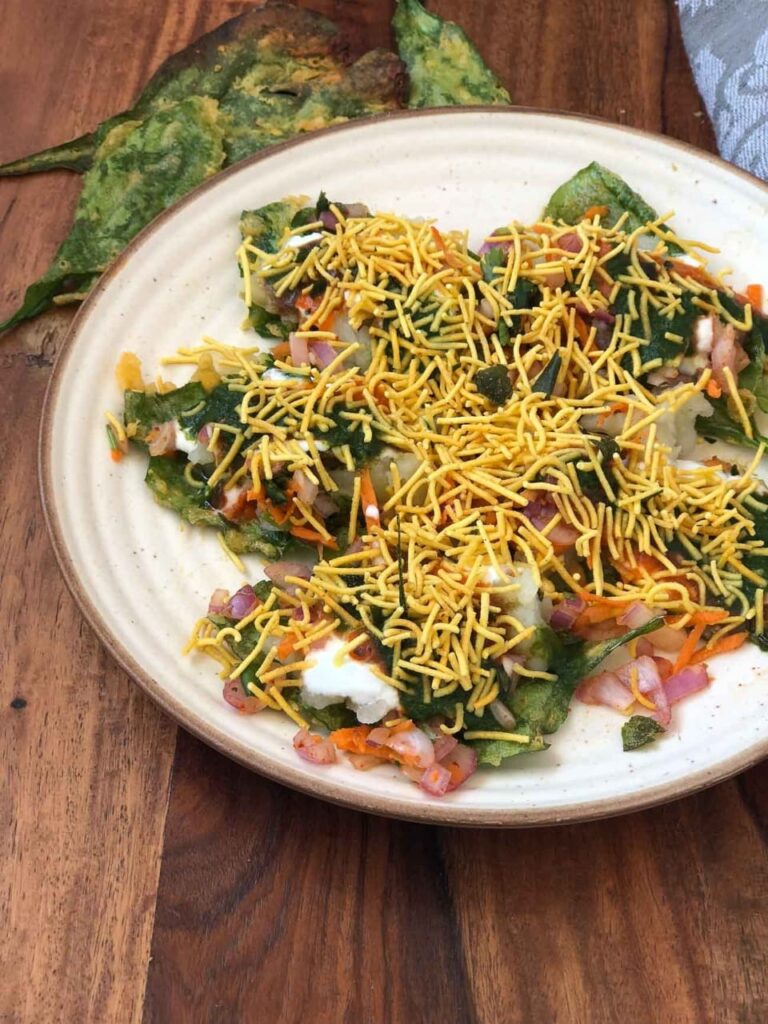
Ingredients:
- Fresh spinach leaves (palak) – about 10-12 large leaves
- Besan (gram flour) – 1 cup
- Rice flour – 2 tablespoons
- Red chili powder – 1/2 teaspoon
- Turmeric powder – 1/4 teaspoon
- Ajwain (carom seeds) – 1/2 teaspoon
- Baking soda – a pinch
- Salt – to taste
- Water – as needed
- Oil – for deep frying
- Green chutney (made with mint and coriander)
- Sweet tamarind chutney
- Thick yogurt – 1/2 cup
- Chaat masala – 1 teaspoon
- Red chili powder – 1/2 teaspoon
- Sev (crispy chickpea noodles) – for garnish
- Chopped onions – 1/2 cup
- Chopped tomatoes – 1/2 cups
Method:-
- Wash and dry the spinach leaves thoroughly. Remove the stems and keep the leaves aside.
- In a mixing bowl, prepare a batter by combining besan, rice flour, red chili powder, turmeric powder, ajwain, baking soda, and salt. Add water gradually to make a smooth, thick batter.
- Heat oil in a deep frying pan.
- Dip each spinach leaf into the batter, making sure it’s well coated, and carefully slide it into the hot oil. Fry until the pakodas are golden and crispy. Drain excess oil on a paper towel.
- To assemble the chaat, place the fried spinach pakodas on a serving plate.
- Drizzle green chutney and tamarind chutney over the pakodas.
- Spoon some yogurt on top and sprinkle with chaat masala, red chili powder, and sev.
- Garnish with chopped onions, tomatoes, green chilies, and coriander leaves.
2) Moong Dal Kachori With Green Chutney

Ingredients:
- (Maida) – 1 cup
- Ghee (clarified butter) – 2 tablespoons
- Salt – 1/2 teaspoon
- Water – as needed
- Split yellow moong dal – 1/2 cup (soaked for a few hours and drained)
- Asafoetida (Hing) – a pinch
- Cumin seeds – 1/2 teaspoon
- Green chilies – 2, finely chopped
- Ginger – 1-inch piece, grated
- Coriander powder – 1 teaspoon
- Red chili powder – 1/2 teaspoon
- Garam masala – 1/2 teaspoon
- Fennel seeds – 1/2 teaspoon
- Salt – to taste
- Oil – 2 tablespoons
Method:-
- Start by preparing the kachori dough. In a mixing bowl, combine all-purpose flour, ghee, and salt. Mix well.
- Gradually add water and knead the mixture into a smooth, firm dough. Cover it with a damp cloth and set it aside to rest for 20-30 minutes.
- While the dough is resting, prepare the moong dal filling. Heat 2 tablespoons of oil in a pan. Add cumin seeds and asafoetida.
- Add the grated ginger and green chilies. Sauté for a minute.
- Add the soaked and drained moong dal. Cook it on low to medium heat until it’s soft and cooked through.
- Stir in coriander powder, red chili powder, garam masala, fennel seeds, and salt. Cook for a few more minutes, then remove it from heat and let it cool.
- Divide the dough into small, equal-sized balls. Roll each ball into a small disc, about 3-4 inches in diameter.
- Place a spoonful of the moong dal mixture in the center of each disc.
- Carefully fold the edges of the disc to enclose the filling, making sure there are no gaps. Pinch the edges to seal the kachori.
- Heat oil in a deep frying pan over medium heat. Fry the kachoris until they are golden brown.
3) Kashmiri Veg Pulao
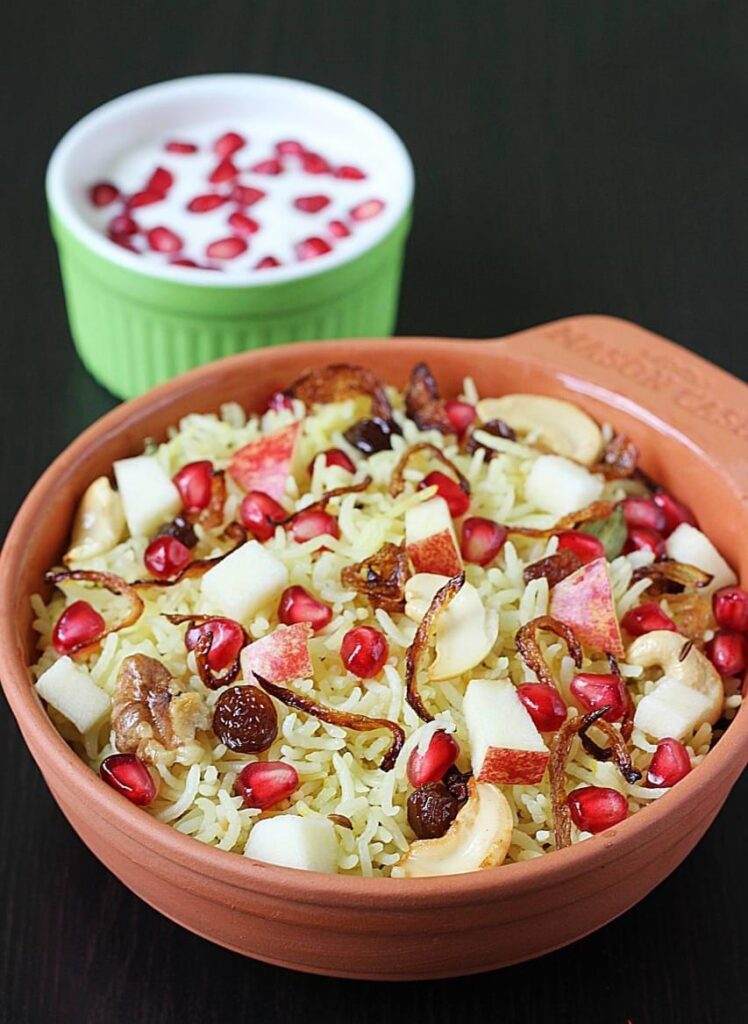
Ingredients:
- Basmati rice – 1 cup
- Mixed vegetables (carrots, peas, beans, etc.) – 1 cup, finely chopped
- Ghee (clarified butter) – 2 tablespoons
- Cumin seeds – 1 teaspoon
- Whole spices (cinnamon, cloves, cardamom) – a few
- Cashew nuts – 1/4 cup
- Raisins – 1/4 cup
- Saffron strands – a pinch (soaked in warm milk)
- Water – 2 cups
- Salt – to taste
Method:-
- Wash and soak the basmati rice for 30 minutes. Drain and set aside.
- In a large pot, heat ghee and add cumin seeds and whole spices. Sauté for a minute until they release their aroma.
- Add cashew nuts and raisins, and sauté until they turn golden.
- Add the finely chopped vegetables and sauté for a few minutes until they are slightly tender.
- Add the drained basmati rice and sauté for a couple of minutes.
- Pour in 2 cups of water and add saffron-soaked milk. Season with
- salt and bring the mixture to a boil.
4) Dhingri Dulma
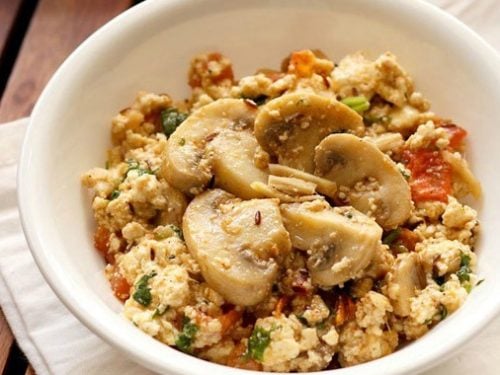
Ingredients:
- Button mushrooms – 250 grams, cleaned and stems removed
- Paneer (cottage cheese) – 100 grams, crumbled
- Onion – 1, finely chopped
- Ginger-garlic paste – 1 tablespoon
- Green chilies – 2, finely chopped
- Fresh coriander leaves – 2 tablespoons, chopped
- Red chili powder – 1/2 teaspoon
- Garam masala – 1/2 teaspoon
- Salt – to taste
- Cashew nuts – 10-12, soaked and ground into a paste (for a creamy texture)
- Fresh cream – 2 tablespoons (optional)
Method:-
- Prepare the stuffed mushrooms: In a pan, heat some oil, add chopped onions, and sauté until they turn translucent. Add ginger-garlic paste, green chilies, and sauté for a few minutes.
- Add crumbled paneer, chopped coriander leaves, red chili powder, garam masala, and salt. Mix well and let the mixture cool.
- Fill each cleaned mushroom cap with the paneer mixture and set them aside.
- Prepare the gravy: In a separate pan, heat oil and add chopped onions. Sauté until they turn golden brown.
- Add ginger-garlic paste and cook for a couple of minutes.
- Stir in red chili powder, turmeric powder, coriander powder, and salt. Sauté for a few minutes until the oil separates.
- Add tomato puree and cook until the mixture thickens and the oil separates.
- Add the cashew nut paste and cook for a few more minutes, stirring well.
- Add garam masala and fresh cream (if using) and stir to combine.
- Place the stuffed mushrooms in the gravy, cover the pan, and simmer on low heat for about 10-15 minutes, or until the mushrooms are tender and the flavors are well absorbed.
5) Kamal Kakdi Ki Subzi
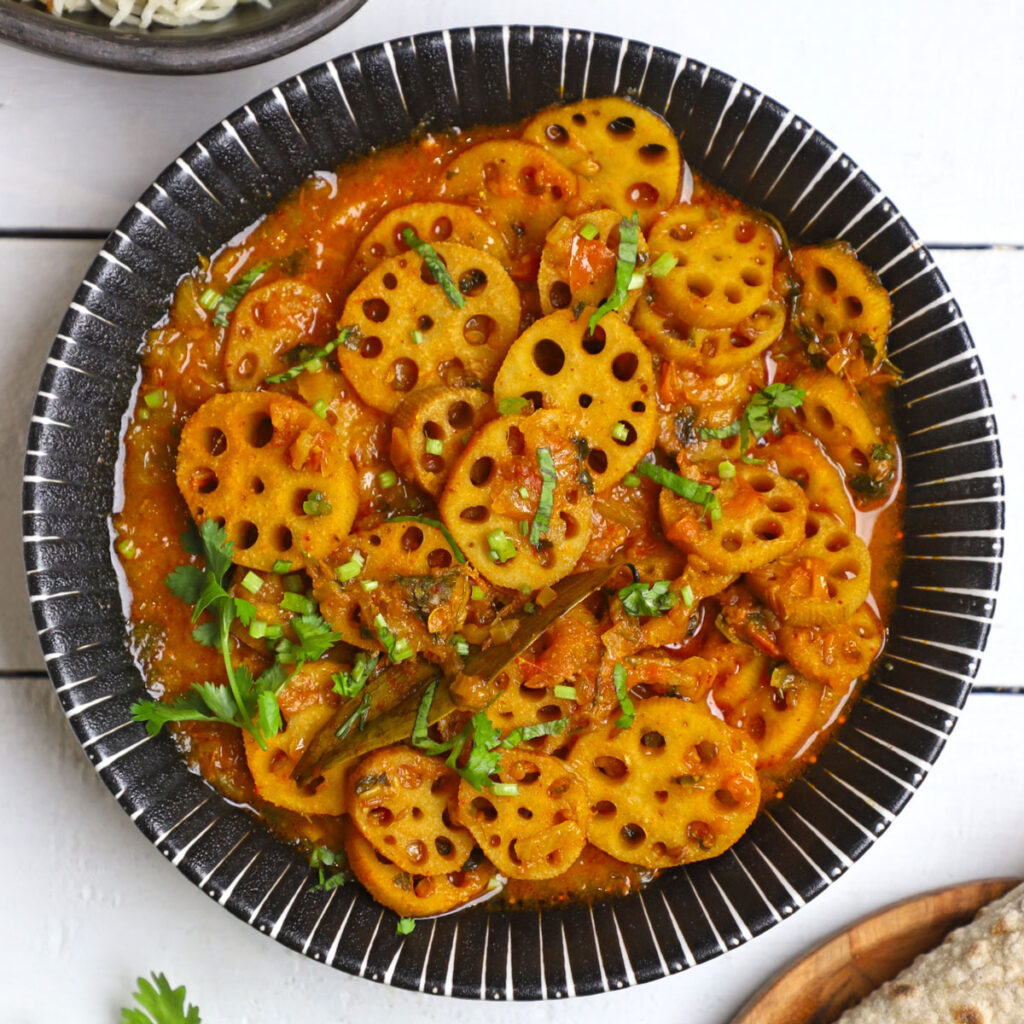
Ingredients:
- Lotus stem (kamal kakdi) – 250 grams, sliced into rounds
- Onions – 2, finely chopped
- Tomatoes – 2, finely chopped
- Ginger-garlic paste – 1 tablespoon
- Green chilies – 2, slit
- Red chili powder – 1/2 teaspoon
- Turmeric powder – 1/4 teaspoon
- Coriander powder – 1 teaspoon
- Garam masala – 1/2 teaspoon
- Cumin seeds – 1/2 teaspoon
- Oil – 2-3 tablespoons
- Salt – to taste
- Fresh coriander leaves – for garnish
Method:-
- Clean the lotus stem thoroughly, peel it, and slice it into rounds. Soak the slices in water to remove any dirt or impurities.
- Heat oil in a pan or kadai. Add cumin seeds and let them splutter.
- Add chopped onions and sauté until they turn golden brown.
- Add ginger-garlic paste and green chilies. Cook for a couple of minutes until the raw aroma disappears.
- Stir in the chopped tomatoes and cook until they turn soft and the oil separates.
- Add red chili powder, turmeric powder, coriander powder, and salt. Mix well and cook for a few more minutes.
- Add the sliced lotus stem and sauté for a couple of minutes to coat them with the spices.
- Add about 1/2 cup of water, cover the pan, and let the lotus stem cook until tender. This may take around 20-25 minutes. You can check for doneness by inserting a knife; it should go in smoothly.
- Once the lotus stem is cooked, sprinkle garam masala and garnish with fresh coriander leaves.
6) Mohanthal Sweet
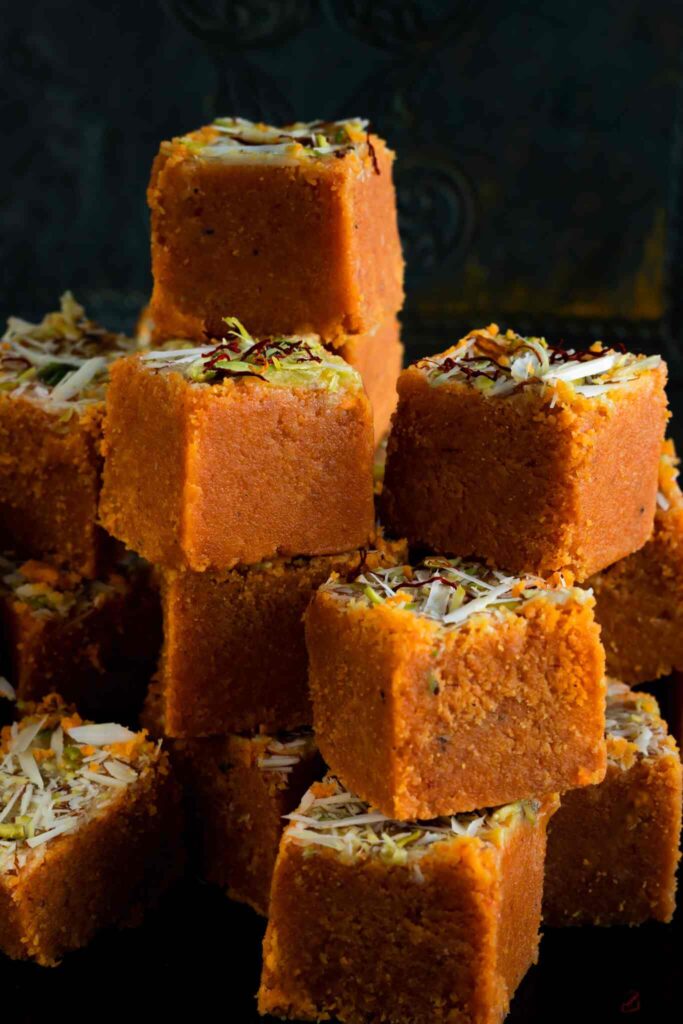
- Besan (gram flour) – 1 cup
- Ghee (clarified butter) – 1/2 cup
- Milk – 1/4 cup
- Sugar – 1 cup
- Water – 1/4 cup
- Cardamom powder – 1/2 teaspoon
- Chopped nuts (almonds, pistachios) – for garnish
- Ghee – for greasing
Method:-
- In a heavy-bottomed pan, dry roast the besan over low to medium heat until it turns aromatic and changes color to a light golden brown. Stir continuously to avoid burning. This may take around 10-15 minutes.
- In a separate pan, heat ghee until it melts. Set it aside.
- In the same besan pan, add milk and mix well. Keep stirring until the mixture thickens.
- Reduce the heat to low and gradually add the melted ghee to the besan-milk mixture. Keep stirring continuously to avoid lumps.
- Continue cooking on low heat, stirring constantly until the mixture starts leaving the sides of the pan and becomes a thick and smooth paste.
- In another pan, make a sugar syrup by dissolving the sugar in water. Bring it to a boil and cook until it reaches a one-thread consistency. You can check this by taking a small drop of the syrup between your thumb and forefinger – it should form a single thread.
- Pour the sugar syrup into the besan-ghee mixture and mix well. Stir over low heat until the mixture thickens and starts leaving the sides of the pan.
- Add cardamom powder and mix it in.
- Grease a plate or tray with ghee and transfer the mohanthal mixture to it. Spread it evenly and garnish with chopped nuts.
- Let it cool and set for a few hours. Once it’s firm, cut it into squares or diamond shapes.
CONCLUSION
In conclusion, Diwali is a vibrant and significant festival that holds a special place in the hearts of millions of people in India and across the world. It is a celebration of light, symbolizing the triumph of good over evil and the dispelling of darkness.
Diwali is more than just a religious festival; it’s a cultural extravaganza that unites families, communities, and people of diverse backgrounds. The festival is marked by the lighting of lamps, the decoration of homes, the exchange of gifts, and the sharing of delicious sweets and savory dishes. It’s a time for prayers, reflection, and the seeking of blessings from deities like Goddess Lakshmi for wealth and prosperity.
Diwali transcends religious boundaries, bringing people together in a spirit of togetherness and joy. It is a time for forgiveness, reconciliation, and new beginnings. The festival’s various traditions and rituals showcase the rich diversity of India’s regions, adding to the tapestry of this beautiful celebration.
Ultimately, Diwali is a time to celebrate the victory of light and righteousness in our lives and to reaffirm the values of love, kindness, and unity. It reminds us to strive for a brighter and more harmonious world. As the lamps are lit and the sweets are shared, Diwali leaves an indelible mark on the hearts of those who participate, emphasizing the importance of light, hope, and the triumph of good in our lives.


